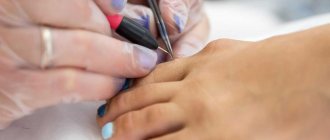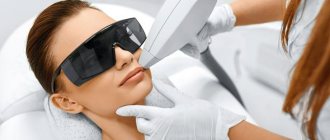From this article you will learn:
- What are the features of the laser hair removal procedure for armpits?
- How to prepare for underarm laser hair removal procedure
- What complications and consequences are possible after laser?
- In what cases should you refuse laser hair removal of the armpits?
- Can laser get rid of hair forever?
Every representative of the fair sex tries to get rid of excess hair on the body. However, the usual shaving and waxing are not suitable for everyone, since the effect of these procedures is very short-lived. To prevent unwanted hairs from appearing for a long time, you should go to a clinic or salon, where laser hair removal of the armpits has recently become especially popular.
Features of the laser hair removal procedure for armpits
Laser hair removal of the armpits is a hardware method of hair removal, during which the effect occurs directly on the follicles. It is worth noting that the skin is not affected by the beam at all during the procedure.
There are currently four laser-based devices:
- The Alexandrite laser can only be used by those with light hair and skin. As for dark-haired women, as well as tanned and dark-skinned representatives of the fair sex, this method is not suitable for them.
- The diode type of laser, invented in 2007, can be used by people with different skin types and hair colors. In addition, the procedure itself lasts much less time when compared with the previous option.
- The neodymium laser device is suitable for dark and tanned skin. Its effect causes the hair follicle to practically explode due to rapid heating.
- The ruby laser type is the earliest invention and is practically not used today. It can only be used on dark hair and light skin. In addition, in terms of speed of impact, this device is significantly inferior to all previous ones.
The most popular today are diode and alexandrite lasers.
The advantages of such lasers are as follows:
- No discomfort. While classical methods of removing hair in the armpit area often cause irritation and redness, laser hair removal does not cause any discomfort to a woman and does not provoke negative reactions from the skin.
- Duration of action. If after shaving the hair begins to grow the very next day, then after laser exposure it does not appear for much longer, and subsequently becomes thinner. The effectiveness of the procedure lasts for one to two months, depending on the hair type.
- Economical. If you calculate how much money is spent on razors, sugaring and waxing, the cost of several sessions of laser hair removal for the armpits will be much less.
To be more effective from this procedure, you need to know how to prepare for it. It is worth considering that hair absorbs the laser beam best if it has a color contrasting with the skin. Therefore, a few weeks before the session you need to avoid visiting the solarium. In addition, you should not use a razor or wax for 14 days before hair removal. You need to shave your hair one or two days before the procedure, and before the procedure itself, cleanse your skin of deodorant.
Considering that the dermis in the armpits is quite sensitive, it is worth asking a specialist for pain relief. Even though modern hair removal devices are equipped with a cooling system, which significantly reduces discomfort, some women still experience discomfort.
Read material on the topic: Laser aesthetic cosmetology: perfect technology for perfect appearance
Duration of hair removal course depending on the affected area
As strange as it may sound, it is more difficult to remove hair on the face than, for example, on the legs. Depending on the zone, the number of procedures required to completely remove vegetation and the duration of the course itself vary. At the same time, the course is lengthened due to a larger number of procedures and due to different lengths of intervals between procedures.
It is necessary to plan a second and subsequent visits to a laser therapist when the hairs have grown sufficiently after the previous removal. The maximum effect of the procedure will be obtained when the maximum number of follicles enters the active growth phase, since it is these active follicles that are most sensitive to laser radiation.
On different parts of the body, the rate of activation of hair growth is different. The optimal frequency of sessions for removing mustaches above the upper lip is 4-5 weeks, for the forearms at least 6 weeks, for the legs 3 months. The more procedures are done within the course, the longer the interval may be required to activate the “dormant” follicles and move them into the active growth phase.
If a person epilates more often than necessary, there will not be much harm. But the benefit is also questionable, since this will only unreasonably increase the number of procedures required to completely remove hair from a problem area of the face or body.
How many laser hair removal procedures for armpits will be needed?
The procedure must be repeated several times, since during one session only 5–30% of all vegetation is removed. As for how long laser hair removal of the armpits lasts, this is an individual question, and it depends on the area being treated. As a rule, for perfectly smooth skin it is necessary to perform the procedure multiple times. Laser-damaged hair either grows more slowly or disappears completely. However, those instances that were in a dormant state at the time of the session begin to appear. Typically, hair change lasts from eight months to two years.
After laser hair removal of the armpits four times, about 40% of the hair remains. No specialist can guarantee that you will be able to get rid of hair completely, since the result depends on many factors, including disorders in the endocrine system, hormonal changes, etc.
Recommended articles on the topic:
- Laser stretch mark removal in a beauty salon: pros and cons of the procedure
- Thermal detoxification: lightness of the body and clear skin
- Laser scar resurfacing is a modern way to get rid of skin imperfections
After completing a full course of laser hair removal, skin smoothness remains for six years. However, there is a rule that cannot be broken. Between procedures, it is unacceptable to use other methods of hair removal, with the exception of regular shaving.
As for the number of sessions required to effectively get rid of vegetation, everything is individual and depends on the characteristics of each woman’s body. At your first visit to a cosmetologist, a specialist will never tell you exactly how many procedures will be needed in a particular case. This will become clear after about five sessions. However, as a rule, 6–9 epilations are enough.
After the first session, some women feel that their hair, on the contrary, began to grow even faster. However, this sensation occurs due to the loss of particles located in the affected follicles. This process can last up to four weeks, and you cannot remove them yourself with a razor, tweezers, or wax. A week after laser hair removal, you can use a scrub that will help get rid of falling hairs.
After 14 days, the skin will acquire ideal smoothness, but after some time, specimens that were “dormant” begin to appear. This indicates that it is time to re-epilate. As a rule, the time interval between the first and second session is approximately 1.5 months.
In some cases, after two hair removal procedures have been performed, the hair begins to grow back even more. However, there is no need to worry about this, as this makes subsequent hair removal even more effective.
Read the material on the topic: How to get rid of unwanted hair quickly, painlessly and forever
Number of procedures depending on skin and hair color
The ideal client for laser hair removal is a person with white skin and dark, coarse hair. People with such external characteristics can achieve satisfactory results much faster than those with dark and fair hair. Tanning can reduce the effectiveness of the effect, the presence of which for some types of lasers is a contraindication for the procedure.
Until recently, laser therapists had nothing to offer to owners of vellus hair, as well as gray and light hair, practically devoid of pigment. Laser machines that were in use until recently did not “take” light and thin hairs. Until now, many are sure that laser hair removal is also contraindicated for dark-skinned people. However, now there are devices that can be used to remove any hair on skin of any phototype from I to VI. Most likely, those with light hair and dark skin will have to undergo more procedures. You can find out how long the course of laser hair removal will last from your laser therapist individually.
Contraindications and recommendations
Like any procedure, laser hair removal of the armpit area has contraindications, among which it is worth noting:
- cancer diseases;
- active stage of tuberculosis;
- diabetes;
- blood diseases;
- lactation;
- pregnancy;
- problems with the thyroid gland;
- sensitivity to light;
- birthmarks located in the area that is undergoing laser hair removal;
- ARVI and influenza;
- herpes in acute form;
- skin burn;
- phlebeurysm;
- tendency to keloid scars;
- age before puberty;
- skin damage in the form of scratches.
Some salons do not perform laser hair removal of armpits for clients who are under 18 years of age, or require parental permission. Some representatives of the fair sex do not tolerate this procedure well. Therefore, before treating the entire area, it is worth checking the skin reaction in one area. For women with blond or gray hair, hair removal may not help at all. Therefore, before going to the session, you need to go for a consultation with a doctor who will give an opinion on your health status.
Read material on the topic: Laser hair removal of the abdomen: contraindications, features of the procedure and care
Effect duration
After completing the main course, maintenance correction will be required once every 2 years. This is due to the fact that during the main hair removal course, not all hairs move from the dormant to the active stage. To eliminate the remains of unwanted vegetation, it will not be necessary to complete the entire course. For a maintenance course, 2-3 hair removal procedures are sufficient.
After the maintenance and main course of hair removal, you must adhere to simple preventive recommendations that will minimize the likelihood of reappearance of body hair. After laser hair removal, you should not comb your hair, use decorative cosmetics, sunbathe or go to the bathhouse for 3 days.
Possible consequences and complications
If we talk about whether laser hair removal of the armpits is harmful, it is worth understanding that the depth of penetration of the beam into the epidermis is very small, about 1–4 mm, and the risk of complications after the procedure is minimal.
However, if the manipulation was performed in the presence of contraindications or by an incompetent specialist, the consequences may be as follows:
- allergy;
- hyperpigmentation;
- burn;
- redness of the skin;
- herpetic rash;
- retinal burn.
As for redness of the skin, it often appears after the procedure, but quickly passes. A retinal burn can only occur if you do not wear special glasses that will protect your eyes. The cosmetologist must give them out before the start of the session.
Read material on the topic: Laser hair removal of the upper lip: effective and reliable or expensive and useless?
Stages of hair growth
Our hair, like our nails, is a derivative of the skin. Hair growth is ensured by bulb cells located on the basement membrane of the hair follicle.
Hair consists of a shaft and a hair follicle (root). The core is the part that we directly see above the skin. The outer part of the hair does not contain living cells. The “living” part is called the follicle (root sheath). Hair producing cells live in it. Each follicle contains a tangle of blood capillaries, which provide nutrition to the follicular cells.
In other words, the appearance of hair occurs due to the hair follicle, which has a complex structure.
All hair on the human body does not just grow, but goes through 3 stages of growth: anagen (active growth stage), catagen (stopping phase) and telogen (atrophy, loss and formation of new hair).
The laser beam can only destroy hair that is in the anagen stage. It does not matter what hair removal method is used. The conductor of influence on the follicle will always be the hair canal.
Let's take a closer look at the stages of hair growth.
Anagen
At this stage, follicle cells are actively dividing and receiving nutrients.
Only at the anagen stage is there a close connection between the hair and the follicle, which allows for effective hair removal. During the procedure, the follicle is completely destroyed, after which hair growth stops.
At the top of the follicle there is a bulge zone. It is from here that stem cells migrate into the matrix, where they begin to grow. Even if the dermal papilla is destroyed, the follicle is able to regenerate (if there are stem cells left in the bulge area). Therefore, the target for the laser is the dermal papilla.
The amount of hair in the anagen stage depends on the location. According to research, approximately 80-88% of hair on the head is in the anagen stage. The rest: 1% is the catagen stage and about 20% is telogen.
In the upper lip area, the percentage of hair in the anagen stage is 65%, and on the legs and bikini line - 30%.
The hair growth cycle is not synchronous. There are both young and old hairs throughout the entire area of the skin.
The duration of the anagen stage also varies:
- on legs and hips - 16 weeks;
- in the bikini area - up to 4 weeks;
- armpits - 16 weeks;
- on the chin - 52 weeks;
- on the upper lip - 16 weeks.
The anagen stage is divided into several more periods of active growth:
- The hair follicle cells enlarge and RNA (ribonucleic acid) is synthesized.
- The hair bulb grows deep into the epidermis, differentiation of cells occurs into different layers of the hair and the outer shell of the root in the matrix ring.
- Continued cell division. The follicle reaches its maximum length. The dermal papilla is fully formed. Melanocytes (cells that produce the melanin we need) are located along the cavity of the dermal papilla. The outer shell of the follicle cavity is an elongated cone.
- Melanocytes begin to produce the pigment melanin. The hair is formed, but does not extend beyond the boundaries of the cone-shaped cavity.
- The bulb takes on its final shape. Hair grows towards the surface of the epidermis.
- The last stage begins after the hair begins to rise above the skin and continues until the catagen phase.
It is not possible to externally calculate the stages of hair growth. During the hair removal procedure, the cosmetologist uses a beam of light on all hair in all stages of growth.
It will also not be possible to control how much hair was in the anagen stage and how many of them were destroyed. In addition, there are individual characteristics of a person (hair thickness, hair color, skin phototype, etc.), procedure technique and other factors. All this affects the final result and the number of procedures required.
After cell division has decreased, the hair follicle contracts and the hair root begins to move towards the surface. The transition to the catagen stage begins.
Catagen
This is a transitional stage in which hair growth slows down. Lasts from several days to 2-3 weeks.
The mitotic activity of matrix cells completely stops. The lower part of the follicle atrophies and moves away from the dermal papilla. The dermal papilla also atrophies, the mass of connective tissues and cellular elements decreases, and the blood vessels become thinner. Hair growth continues, but very slowly.
The catagen stage will not begin until the anagen phase is complete. How long this will take depends on the zone.
Telogen
Telogen is the resting phase (loss). Lasts 3-5 months. At this stage, the hair does not grow and eventually falls off. The hair root becomes keratinized, thickened, with a residue of pigment granules. The hair follicle is located close to the surface of the skin. The hair located in the follicle decreases in size, the hair bulb atrophies. The hair retention mechanism stops working, it is easy to remove when washing, etc. Or it is pushed out by newly formed hair. Sometimes both new and old hair are preserved in the same follicle.
Telogen can last longer than the anagen stage. The maximum duration of this phase on the legs is up to 24 weeks, in the bikini area and armpit – up to 3 months.
The most popular questions about laser hair removal underarms
- Is it possible to get rid of armpit hair forever with laser hair removal?
In this case, there is no 100% guarantee, since no technique can achieve such an effect. Hair removal using a laser eliminates 90% of hair, but for this you need to complete the full course and follow the intervals between procedures recommended by a specialist. If hair subsequently appears, it will be sporadic, and one session per year will be enough to remove it.
- How many procedures need to be performed?
As a rule, six to eight sessions are sufficient to obtain the desired result. The number of procedures, as well as how much laser hair removal of the armpits will cost for each individual client, is determined by the cosmetologist during the consultation.
- What happens to the hair between sessions?
Those hairs that are on the surface burn out during laser treatment. The roots located inside fall out on their own with the renewal of the epidermis. After this, new hair growth begins. When their number becomes such that they begin to interfere, it is necessary to repeat the procedure. It is worth noting that with each subsequent session the hair volume will gradually decrease. The result of laser hair removal of armpits is shown in the photo.
- Do I need to grow my hair for laser hair removal?
In this case this is not required. Hair length for laser treatment should be no more than 3 mm. If required, you can use a razor to remove hair between treatments. But as for removing hair from the root, for example, using wax, tweezers, sugar and an epilator, such methods are not compatible with laser. If one of these methods was used, then at least three weeks must pass before the procedure begins. Only in this case will it be possible to achieve a positive effect.
- Can everyone have laser hair removal on their armpits?
Almost everyone can undergo this procedure, with the exception of those who have very thin and blond or gray hair. As for dark vegetation, the alexandrite laser can handle it in any case, even if it is very thin. If the hairs are light or red, but at the same time quite hard, then you can use a diode device.
- Will hair come back after pregnancy?
If you manage to complete the entire course of hair removal before pregnancy, then the likelihood that hair will begin to grow again is minimal. If a woman finds out about her situation before completing the required number of procedures, then the return of vegetation is possible, but this may not happen. And yet, if you plan to conceive a child, it is best to postpone hair removal until the baby is born.
- Is there any pain during the procedure?
Each person has their own pain threshold, however, according to customer reviews, laser hair removal of the armpits still causes discomfort in the form of tingling. To check whether it will hurt during the procedure, you can ask a specialist to make test flashes in the area where hair removal is planned.
- What is the difference between laser hair removal and photoepilation?
Regardless of which of these procedures is carried out, if everything is done correctly and the body’s response to the effect is adequate, then the effectiveness in both cases is the same. As for photoepilation, the versatility of the method often causes side effects. There are practically no negative consequences from laser treatment of the armpits due to the fixed wavelength.
The operation of the photoepilator is based on the influence of flash lamps. The wavelength is in the range of 510–1020 nm, which allows the device to be used to influence the deeper layers of the epidermis, for example, to treat blood vessels or remove age spots. Although this significantly reduces the selectivity of the lamps.
Although photoflash is very effective and inexpensive, it is not very popular. And this is due not only to the fact that it is difficult to foresee possible side effects and complications. According to specialist research, a positive result is possible only with a contrasting combination of dark hair and light skin. In addition, the procedure must be carried out not just once, but several times, which can lead to damage to the skin and burns.
Another disadvantage of photo flash is that the pain in this case is quite strong when compared with laser hair removal of the armpits. In some situations, discoloration of vegetation is observed, which also cannot be called a positive result. This happens because the melanin in the hairs is simply destroyed, but this does not affect their growth in any way. We can say that hair on the armpits appears much more slowly after laser hair removal, and the method itself is considered more gentle.
Nowadays, you no longer have to spend a lot of time performing complex and unpleasant procedures at home. It is much easier to seek help from real professionals - the Veronika Herba beauty and health center, equipped with effective and modern equipment.
Why clients choose Veronika Herba Beauty and Health Center:
- This is a beauty center where you can take care of yourself at a reasonable cost, while your face and/or body will be treated not by an ordinary cosmetologist, but by one of the best dermatologists in Moscow. This is a completely different, higher level of service!
- You can receive qualified help at any time convenient for you. The beauty center is open from 9:00 to 21:00, seven days a week. The main thing is to agree with your doctor in advance on the date and time of your appointment.
Sign up for a consultation with a specialist by phone +7 (495) 085-15-13
, and you will see for yourself!
Why you can't remove hairs the first time
It is not possible to completely remove body hair in one session. This is due to the fact that hairs can be in 3 phases:
- active - from 15 to 30% of all vegetation visible on the body;
- sleeping;
- loss.
The laser beam affects only hairs in the active growth stage. After the procedure, new vegetation from “dormant” follicles may appear on the skin. Therefore, the cosmetic procedure will need to be repeated to ensure smoothness of the body.
After the first session, the laser removes 50% of visible hair on the body. They do not fall out immediately, but 10-14 days after the procedure. It is worth talking about the ineffectiveness of hair removal if there is no visible result 4 weeks after the session.
After the third visit to the cosmetologist, “dormant bulbs” will begin to grow. To suppress their growth, another 1-2 sessions of laser hair removal will be required. After the fifth procedure, about 80% of all vegetation will be removed from the body surface.
Subsequent maintenance sessions will remove up to 90% of unwanted vegetation. The result is excellent and has a lasting effect!
You cannot stop at one procedure. Otherwise, the financial costs will be in vain.
After each session, the number of total hairs on the body decreases by 10-25%. To obtain optimal results, an average of 5 laser hair removal sessions will be required.
What should be the length of hair?
For a high-quality session, it is necessary that the length of the hair in the treatment area be less than 2 - 3 mm. This is an indicator for all types of procedures. Hair length is an important factor on which the results of the procedure directly depend. If the vegetation exceeds the recommended values, the risk of overheating of the follicle increases, which in turn will lead to injury and burns of the skin. Pigment spots, inflammation, burning, and peeling may appear on the treatment area, but the follicle itself may not die.
How to properly prepare for the first procedure?
Proper preparation for laser hair removal is the key to obtaining the desired result and the absence of negative consequences. Therefore, it is necessary to take the preparatory procedures responsibly, not ignore the doctor’s recommendations, and ask questions about unclear points.
Laser hair removal today is one of the most effective methods of radical removal of unwanted hair, which has many advantages:
- painlessness;
- long lasting effect;
- no irritation or damage to the skin;
- affordable price.
The procedure is recommended for patients over 18 years of age. The technique is suitable for people who have a natural stripe color from light brown to dark. Moreover, the darker the hairs, the better they are removed. The essence of the technique is to apply the destructive properties of a laser to the hair follicle. A laser hair removal device generates radiation that interacts with the pigment found in the hair. Due to this, the hair shaft and root are heated, as a result of which the follicle is destroyed and hair growth stops for a long time.
A dermatologist-cosmetologist at the Medial clinic will tell you what to do before laser hair removal and how to properly prepare for it. By following all the recommendations, you will protect your skin from increased heat load, eliminate the risks of pigmentation, burns, peeling and irritation.











